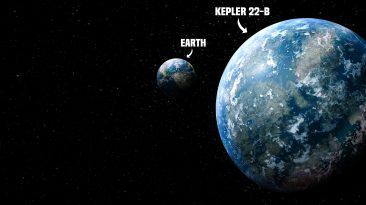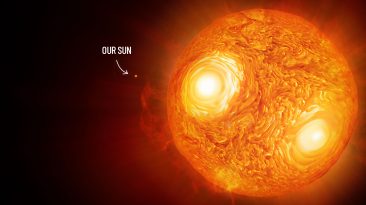As our biggest planet, Jupiter’s immense presence helps to hold our solar system together. Its massive size and gravitational pull give it a dense atmosphere, a turbulent mix of hydrogen and helium. This results in unfathomable storms that have lasted for centuries.
But let’s imagine Jupiter came in closer contact with an even bigger object, the Sun. Would the Sun strip Jupiter of its atmosphere? And if so, what would it look like? What makes Jupiter such a unique gas giant? What is Jupiter’s core made of? What are Hot Jupiters and Hot Neptunes?
Jupiter’s gravity is nearly two and a half times stronger than Earth’s, making it difficult for any atmosphere to escape. Thankfully it also keeps out incoming asteroids.
Jupiter has dense layers of gas, consisting of 90% hydrogen and 10% helium and a few traces of ammonia, sulfur, methane, and water vapor.
It has an extended, dilute core made up of rocky material, ice, hydrogen, and helium. Unlike Earth, there is no sharp transition between Jupiter’s core and its outer atmosphere.
Scientists believe the core could have been formed from a head-on collision about four and a half billion years ago between Jupiter and a planetary embryo 10 times more massive than Earth. A recent discovery of the exoplanet LTT 9779b by NASA’s Transiting Exoplanet Survey Satellite, or TESS, may unlock even more answers to Jupiter’s formation and possible destruction.
NASA’s discovery of the Jupiter-like exoplanet LTT 9779b has captivated the scientific community with its miraculously close orbit to its star. While Jupiter maintains a safe distance from the Sun, LTT 9779b is so close to its star that its atmosphere is evaporating at an accelerating pace.
What makes it so unique is that close orbits are usually reserved for Earth-like or Jupiter-like planets. But LTT 9779b is somewhere in between, closer in scale to Neptune.
With an ultra-hot temperature of about 1,725 °C (3137 °F), astronomers have unimaginatively named it Hot Neptune. Very clever, guys. Personally, I would have gone with The Blue Inferno.
Astronomers believe that the exoplanet may have formed further away from its star and has slowly made its way closer and closer over millions of years. The closer it gets to its star, more and more of its atmosphere evaporates, giving it a squished, almost football-like appearance.
LTT 9779b is losing its atmosphere because it has surpassed the critical distance where a planet begins to lose mass due to the tidal forces caused by another celestial body. This is known as the Roche limit.
Luckily, Jupiter is far away enough from the Sun to maintain its mass. And its moons are far enough away from Jupiter not to be absorbed. So why do most gas giants, like Jupiter, reside far away from the Sun?
Well, all planets were built in the same way. The Sun’s gravity pulled dust and rock together. While the Sun burned off gases such as hydrogen and helium in the inner solar system, the outer parts stayed cool. This provided just the right temperature and materials for planets to form atmospheres.
Some astronomers have suggested that there are Earth-like planets out there that may have once been gas giants. For unknown reasons, they have entered the Roche Limit and lost all their atmosphere, becoming hot Earths.
There are even hot Jupiters out there, like the exoplanet 51 Peg, which is similar in scale and orbits its star every four days. For Jupiter to start losing its atmosphere, it would need to come closer to the Sun and surpass its Roche limit.
While this isn’t likely to happen, if Jupiter got nudged toward the Sun, it would slowly start to spiral closer and closer to it. It would lose more mass with each orbit. Eventually, it would get so close that it would orbit the Sun in a single day, 88 times faster than Mercury’s orbit.
The Sun’s strong solar winds would give Jupiter a tail of gas like a comet. This enormous amount of gas could cloud the light of many stars, making our night sky much less impressive.
During this slow process, Jupiter would be squished and eventually lose its atmosphere. It would be left looking like a barren, rocky planet like Mercury but about the size of 11 earths.
As we continue to explore and discover more exoplanets like Hot Jupiters or Hot Neptunes, scientists can better understand planet formation, which is vital to our understanding of the Universe. Maybe Jupiter losing its atmosphere could be a good thing.
Sources
- “Jupiter’s Atmosphere & The Great Red Spot”. Nola, Taylor Redd. 2021. space.com.
- “Planet Jupiter: Facts About Its Size, Moons And Red Spot”. Charles, Q. Choi. 2021. space.com.
- “In Depth | Jupiter – NASA Solar System Exploration”. 2021. NASA Solar System Exploration.
- “Can a huge impact explain Jupiter’s quirky core?”. 2019. Physics Today. doi:10.1063/pt.6.1.20190828a.
- “Jupiter’s Strange Core May Have Been Forged By A Colossal Head-On Crash”. Chelsea, Gohd. 2021. space.com.
- “The formation of Jupiter’s diluted core by a giant impact”. iu, Shang-Fei, Yasunori Hori, Simon Müller, Xiaochen Zheng, Ravit Helled, Doug Lin, and Andrea Isella. 2019. Nature 572 (7769): 355-357. doi:10.1038/s41586-019-1470-2.
- “TESS has found the first-ever ‘ultrahot Neptune’’”. Lisa, Grossman. 2019. Science News.
- “Earth Fact Sheet”. 2021. nssdc.gsfc.nasa.gov.



























